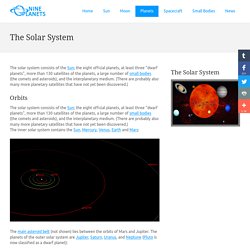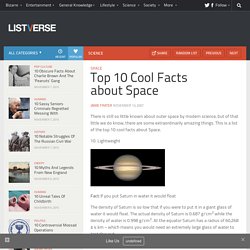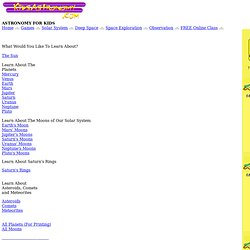

An Overview of the Solar System, it's alignment and pictures. The solar system consists of the Sun; the eight official planets, at least three "dwarf planets", more than 130 satellites of the planets, a large number of small bodies (the comets and asteroids), and the interplanetary medium.

(There are probably also many more planetary satellites that have not yet been discovered.) The inner solar system contains the Sun, Mercury, Venus, Earth and Mars: The main asteroid belt (not shown) lies between the orbits of Mars and Jupiter. The planets of the outer solar system are Jupiter, Saturn, Uranus, and Neptune (Pluto is now classified as a dwarf planet): The first thing to notice is that the solar system is mostly empty space. The orbits of the planets are ellipses with the Sun at one focus, though all except Mercury are very nearly circular. (The above diagrams show correct positions for October 1996 as generated by the excellent planetarium program Starry Night; there are also many other similar programs available, some free.
Sizes Pictures. Top 10 Cool Facts about Space. Space There is still so little known about outer space by modern science, but of that little we do know, there are some extraordinarily amazing things.

This is a list of the top 10 cool facts about Space. 10. Lightweight Fact: If you put Saturn in water it would float The density of Saturn is so low that if you were to put it in a giant glass of water it would float. 9. Fact: We are moving through space at the rate of 530km a second Our Galaxy – the Milky Way is spinning at a rate of 225 kilometers per second. 8. Fact: The moon is drifting away from Earth Every year the moon moves about 3.8cm further away from the Earth. 7. Fact: The light hitting the earth right now is 30 thousand years old The energy in the sunlight we see today started out in the core of the Sun 30,000 years ago – it spent most of this time passing through the dense atoms that make the sun and just 8 minutes to reach us once it had left the Sun!
6. Fact: The Sun loses up to a billion kilograms a second due to solar winds. Solar System, Solar System Information. Our Cosmic Neighborhood From our small world we have gazed upon the cosmic ocean for thousands of years.

Ancient astronomers observed points of light that appeared to move among the stars. They called these objects "planets," meaning wanderers, and named them after Roman deities—Jupiter, king of the gods; Mars, the god of war; Mercury, messenger of the gods; Venus, the goddes of love and beauty, and Saturn, father of Jupiter and god of agriculture. The stargazers also observed comets with sparkling tails, and meteors or shooting stars apparently falling from the sky. Since the invention of the telescope, three more planets have been discovered in our solar system: Uranus (1781), Neptune (1846), and, now downgraded to a dwarf planet, Pluto (1930). The four planets closest to the sun—Mercury, Venus, Earth, and Mars—are called the terrestrial planets because they have solid rocky surfaces.
Nearly every planet—and some of the moons—has an atmosphere. Space. The Solar System - Astronomy For Kids - KidsAstronomy.com. Our solar neighborhood is an exciting place.

The Solar System is full of planets, moons, asteroids, comets, minor planets, and many other exciting objects. Learn about Io, the explosive moon that orbits the planet Jupiter, or explore the gigantic canyons and deserts on Mars. What Is The Solar System? The Solar System is made up of all the planets that orbit our Sun.
In addition to planets, the Solar System also consists of moons, comets, asteroids, minor planets, and dust and gas. Everything in the Solar System orbits or revolves around the Sun. How Did The Solar System form? This is an important question, and one that is difficult for scientists to understand. Scientists believe that the Solar System evolved from a giant cloud of dust and gas. At the center of this spinning cloud, a small star began to form. Further away from the center of this mass where the star was forming, there were smaller clumps of dust and gas that were also collapsing.
A Great Storm.